Shaggy Parasol
Shagginess in the Bay Area

It is big, has flat brown scales on a whitish cap, an ornate ring on the smooth stalk and grows under cypresses. What is it? Shaggy Parasol!
Once upon a time
To translate Shaggy Parasol into a Latin name is a little harder and brings us to the history of naming mushrooms.
David Arora’s “Mushrooms Demystified” lists this species as Lepiota rachodes and also mentions two other genus names for this species: Leucoagaricus and Macrolepiota. Let us look at those genera and their names one by one.
Lepiota is the genus name, given in the past to all those white-spored scaly mushrooms with free gills that did not answer to the name Amanita — because their gill trama is different. Just for the record, Lepiota was split off from Agaricus, the genus that encompassed all gilled mushrooms. In the second half of the 19th century, more and more different genera came into use.
To see a graphical representation of the new genera, click here.
Lepiota was also divided up. First the genus Leucocoprinus was recognized, for dainty species with a grooved pileus surface, very much reminiscent of ink caps (Coprinus species) but with white spores (hence the ‘leuco’ – Latinized Greek for white – in front of Coprinus). The yellow flowerpot ‘lepiota’ is an example.
Chlorophyllum with green spores was next — spore print color was considered an extremely important character. But keep in mind that Chl. molybdites was also given the name Lepiota morganii in the beginning of the 20th century.
Leucoagaricus and Macrolepiota were mid-20th century genera, followed by Cystolepiota to include species with a powdery cap surface.
Leucoagaricus is the genus that harbors L. naucina, now known as Leucoagaricus leucothites, “the woman on the motorcycle,” the all-white big flat-capped lawn mushroom, and La. americanus, a wood chip and compost species with a fat stalk which turns first yellow and then red when pestered. Many of the species commonly called Lepiota belong here: L. atrodisca, L. flammeotincta, L. roseilivida, L. rubrotinctoides to name a selection.
Macrolepiota is best known for M. procera, that beautiful European species with a brown scaly cap, and a long, tiger-striped stalk. The stalk is covered in a brown tissue that breaks open horizontally as the stipe grows; a similar pattern is observed in the down on the stalks of Fatsia plants, a rather common garden plant in the Bay Area (in colder regions it is a house plant). Shaggy parasols also found a place in the genus Macrolepiota.
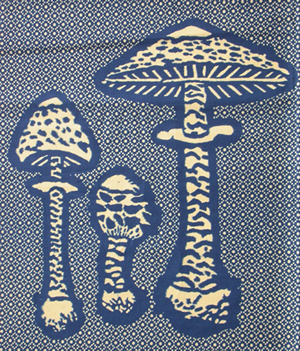 |
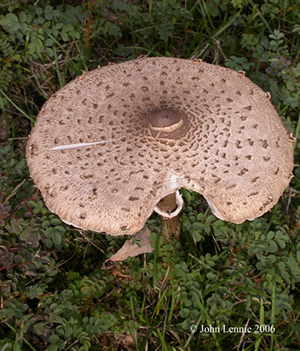 |
| An anatomically correct Macrolepiota species on African cloth |
The real Macrolepiota procera, photographed here in the Netherlands |
So far, all these genera are rather easily recognized in the field, though there are also microscopical characters that count. By now, what was left in Lepiota were species such as L. cristata, L. clypeolaria, L. josserandii, and L. aspera.
But to really figure out how the different groups are related, other characters than those morphological ones are needed. For one thing, mushrooms are not very rich in character, a fruitbody is a simple affair, and many of its characters, color for instance, are hard to quantify. Fortunately, it is now possible to compare bits of DNA from different species to discern patterns of a common evolutionary history and to highlight the differences among them.
DNA comparisons tell us that: Lepiota species (in the restricted sense) cluster together in one clade (with these new techniques come new terms), including Cystolepiota species; Leucoagaricus and Leucocoprinus are intermixed and form one big intertwined group; big surprise, Macrolepiota has to be split up — with some species close to Chlorophyllum molybdites and others in Macrolepiota. The two groups are not like twins, but resemble more two non-consecutive siblings on the family tree (a tree which also includes Agaricus in the modern sense, and puffballs in the genera Lycoperdon, Bovista, Calvatia, Tulostoma and many others).
Shaggy parasols are taken out of the comfortable genus Macrolepiota and accommodated in Chlorophyllum. Originally, Chlorophyllum was erected for the green-spored parasol, hence the name ‘green plate’ (from the Greek), now the genus houses green-spored and white-spored species. These genus names are labels to recognize them, and do not refer to their properties. Just as human family names were originally given for someone’s character or profession, (Smith, Young etc.), now the name and the meaning of that name lack connection. Matt Smith exemplifies this: he is a mycologist by profession, not a smith.
In short, Chlorophyllum rachodes is now one name used to address the Shaggy Parasol.
Local Chlorophyllum species
The local guide book, David Arora’s “Mushrooms Demystified,” recognizes two varieties of L. rachodes: var. rachodes and var. hortensis, which are clearly different, especially in the base of the stem, with a flattened bulb in the latter. Also microscopically there are distinct differences, especially in the shape of the cells on the lamella edge (cheilocystidia). And to top it, the two differ also in their genes — enough differences to recognize them on species level, with the following names: Chl. rachodes and Chl. brunneum.

Chlorophyllum species discolour red on the stipe and when cut;
the reaction is shown in Chl. rachodes
Both species are common in the Bay Area, with Chl. rachodes the more unusual of the two. They grow in gardens, under cypresses, on compost heaps, along roads — all kinds of places where humans have enriched the soil with nitrogen. A very similar species, found further north in the Pacific Northwest, is Chl. olivieri, with scales on the cap that do not stand out. The Southeastern United States sports another species in this group, Chl. subrhacodes.
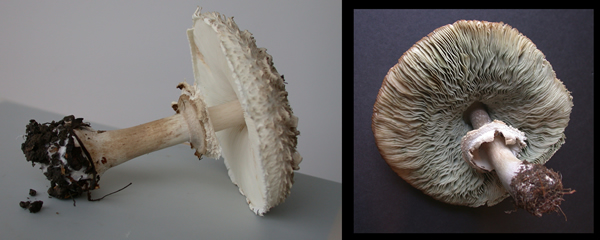
Chlorophyllum rachodes on the left, Chlorophyllum molybdites on the right © John Lennie & else c. vellinga
The third species in the Bay Area is Chlorophyllum molybdites, with green spores. The spores get their green tinge late in the development, and the gills may look white for a long time. A spore print will make clear the difference. It is a very variable species, and can look totally different under different circumstances.
Chl. molybdites is much more common in the warmer areas of California, such as the Los Angeles basin and the Central Valley. It occasionally pops up in the Bay Area; a few years ago it consistently fruited near a greenhouse off the UC Berkeley campus. It can grow in the same kind of habitats as the other species, but is especially common in lawns. In Denver this summer, they could be spotted easily from the car.
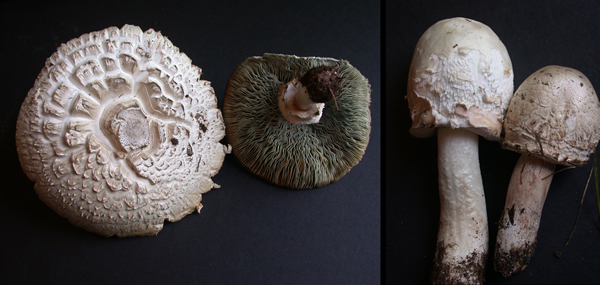
Chlorophyllum molybdites in different stages. © else c. vellinga 2008
For the record, Macrolepiota species have not been found in this part of California. They are very uncommon in Western North America, but several undescribed species occur East of the Rocky Mountains.
Can we eat it?
Chlorophyllum molybdites does not go down well in most people. It wants to leave you, soon, in quite violent and utterly unpleasant ways.
Chlorophyllum brunneum can develop a green cast to the area of the lamellae near the stipe. In that stage it is also not so good to eat anymore. And, several people cannot eat Chl. rachodes and its look alikes anyway, because of allergic reactions.
Another matter of concern — some mushroom species are good at accumulating heavy metals and other not so good components from the soil in their fruitbodies. Watch out where you pick those species for the table!
But, fresh young Shaggy Parasols are sought after and are, well-cooked, a pleasure in pasta dishes.
Macrolepiota species, are all fine, good edibles, and some are even cultivated (e.g., in Thailand).
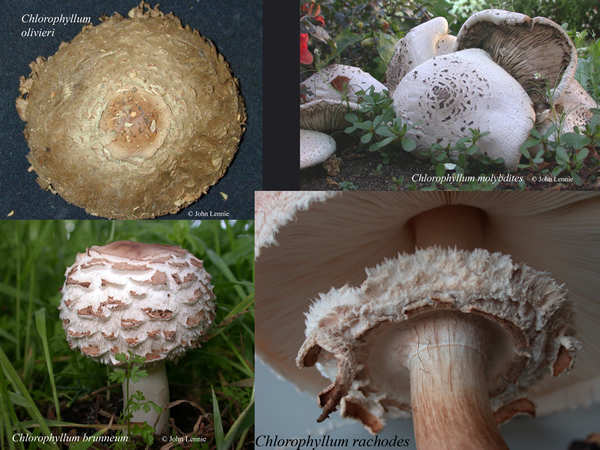
© else c. vellinga 2008

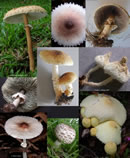
 back to top
back to top